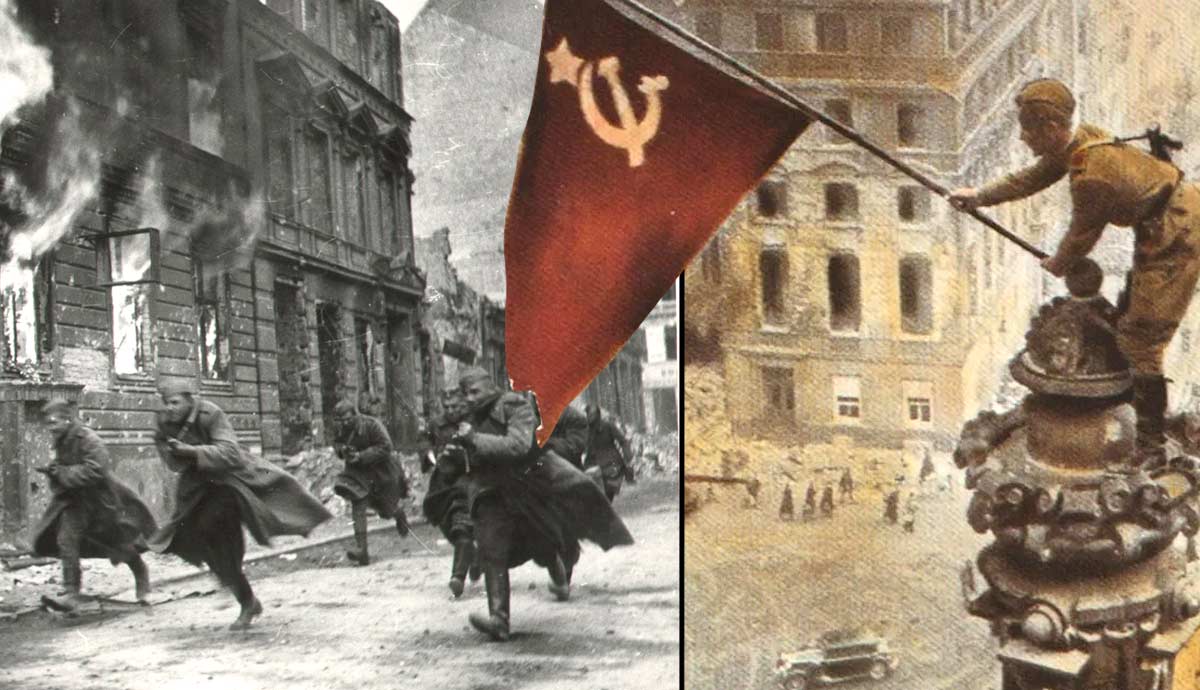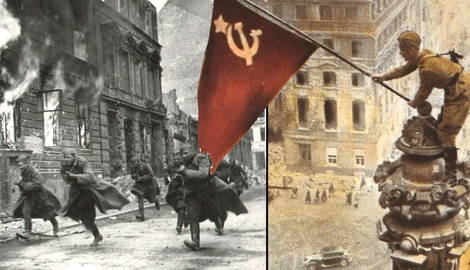
After almost six long years of horrific destruction across the continent of Europe, the Nazi regime crumbled. Rather than surrender, Hitler was obsessed with fighting until the very end. His sentiments were echoed by many of the people of Germany, who saw death as a preferable alternative to capitulation.
The Germans made their stand in Berlin, where Soviet armies had tightened the noose and advanced with vigor as their prize was finally within their grasp. Possessed by zealous devotion to their Führer, ardent Nazis refused to give up. Women, children, and older men took up arms and resisted till their very last.
Advance to Berlin

Along the entire Eastern Front, Soviet armies were advancing. On January 12, the Vistula–Oder Offensive began, and the Soviets crossed the Narew River, pushing deep into Poland directly towards their final target of Berlin. Meanwhile, in the South, Budapest, the capital of Germany’s ally, Hungary, was taken.
On the Western Front, the Germans were under immense pressure, too, as the Allied armies pushed through France and into the heartland of the Reich.
Thirty-seven miles east of Berlin, the Soviet armies ended the Oder-Vistula offensive for an operational pause to reassess their supply lines and gather forces for the final assault on the German capital. The rapid advance had stretched the supply lines to breaking point, and time was needed to bring more supplies from the rear. Any further advance would have left the Soviet northern flank open to a German counterattack from Pomerania.
This gave the Germans time to prepare a more effective defense.
The Battle for Berlin started on April 16 when the Soviets resumed their offensive and attacked the city from the east and the south.

Meanwhile, the Western Allies had decided not to interfere with the Soviet plans to take Berlin. They were of the view that since the city would fall under Soviet influence after the war, there was no point in risking the lives of British, American, and other Western Allied forces. Doing so increased the chances of friendly fire incidents, so the Western Allies restricted operations to bombing raids in preparation for the Soviet advance.
Several German armies surrounded Berlin. Of significant importance was Army Group Vistula, which held the center. Under the capable command of Colonel General Gotthard Heinrici, German forces were ordered to pull back from the Oder River towards Seelow Heights, where better defenses could be prepared.
He then ordered the destruction of a dam to turn the floodplain of the Oder River into a swampy morass to slow down the Soviet advance, buying precious time for the German defenders.
Meanwhile, against the advice of his generals, Hitler remained in Berlin, convinced that a miracle would save the city from the Soviet offensive.

The Germans had a total of 766,750 soldiers, supplemented by 40,000 Volkssturm militia, as well as the Berlin police force and the Hitler Youth. Estimates on the total number this provided are hard to determine. Throughout this force, morale was low. The threat of complete defeat was in the air while the soldiers suffered from food shortages. To add to their woes, relying on any formidable armored and aerial support would be impossible due to the critical lack of fuel that the Third Reich was suffering.
The Soviets, in contrast, had 2,300,000 soldiers split into the First and Second Belorussian Fronts and the First Ukrainian Front. Fighting at their side were the First and Second Polish Armies.
The Fight for Berlin Begins

From April 16-19, the fighting concentrated around Seelow Heights, and the Soviets pushed into the city. This was the last pitched battle of the war, and both sides fought with bitter determination.
With one million men and 20,000 tanks, the Soviets, under the command of Georgy Zhukov, Ivan Konev, and Konstantin Rokossovsky, outnumbered the Germans. Zhukov’s First Belorussion Front led the attack to break through Seelow. Thousands of rockets and artillery shells pounded the German defenses in a stunning bombardment that shook the ground. While this preparation softened the German defense, it also worsened the terrain for the Soviet armored thrust, and traffic jams formed as the Soviets tried to move their vehicles across the Oder River on hastily built pontoon bridges and onto ground pock-marked with craters.

Nevertheless, by April 19, the Soviets had broken through, sustaining 30,000 casualties in the process and inflicting 12,000. Zhukov drove a wedge between Army Group Vistula and Army Group Center, and after this breakthrough was achieved, nothing but fragmented resistance existed between his army and the streets of Berlin.
The Soviets had lost almost 800 tanks in just three days in securing the breakthrough at Seelow Heights, but they still had far more than they needed to finish off the Third Reich completely.
Meanwhile, Konev’s First Ukrainian Front had experienced considerably easier success, crossing the Spree River and advancing on Berlin from the South.
On April 20th, Hitler celebrated his last birthday. On the same day, artillery from the First Belorussian Front opened fire on the city. The bombardment did not stop until the city fell more than two weeks later.
Berlin

The size of the Soviet attack was overwhelming. Within days, the city was completely encircled, and Soviet armies continued their push towards the American lines to the west. Between these two forces, the German troops had nowhere to retreat.
Attempting to break the plans for encirclement, the Germans Army Group Center, under the command of Field Marshal Ferdinand Schörner, attempted a counterattack against the First Ukrainian Front. Hitler made plans for counterattacks, expecting the Germans to be able to defeat their foes in a series of envelopments and pincer movements, but these expectations were unrealistic at best.

On April 22, when he was informed that his armies did not have the manpower or ammunition to carry out such a plan, Hitler flew into a fit of rage, blaming his generals for failing him and the German people for being too weak to live up to his expectations. He declared that he would remain in the bunker and take his life when the time came.
General Alfred Jodl informed Hitler at this point that General Walter Wenck’s Twelfth Army, battling the Americans to the west, could be disengaged as the Americans were unlikely to move further eastwards for fear of overstepping their agreement with the Soviets. It was possible that the Ninth Army and the command of Theodor Busse could move westwards and link up with the Twelfth.
Ultimately, this plan would come to naught. The Soviet forces were just too numerous. On the morning of April 22, the center of Berlin was within range of Soviet field artillery, and key buildings and structures were targeted. Two days later, the Soviet armies had linked up, and the encirclement was completed. Around 100,000 German troops were trapped in the cauldron while all around them, over two million Soviet soldiers tightened the noose.

In charge of these 100,000 men, which included the Volkssturm militia, Hitler Youth, and Berlin police, was General Helmuth Weidling. His task was unenviable and ultimately pointless. Nevertheless, the Germans would fight on. Many German soldiers preferred death to capture by the Soviets. Over the years, German propaganda had instilled the belief that the Soviets were brutal monsters that would offer no mercy.
Indeed, the revenge taken on Germany by the Soviets played into this propaganda. The Soviets had suffered well over 20 million dead at the hands of the Germans in a war of genocide—in fact, the biggest genocide in history. The Soviets were certainly in no mood for any kind of mercy at this point.

As such, many Germans felt it would be better to die in combat than to surrender. Many Germans even committed suicide rather than have to deal with Soviet vengeance. Those women who committed suicide were spared the indignity of rape. It is estimated that as many as 1.4 million women were raped by Soviet soldiers throughout Germany at the end of the war.
To make matters worse, any German suspected of trying to surrender risked being caught and executed by the SS.
Final Victory

Soviet forces fought their way to the center of Berlin: the Reichstag. Although it had not been in use since 1933, Stalin saw it as the spiritual center of the Third Reich, and it needed to be taken to put an end to the Nazis symbolically.
Resistance was stiff, especially at Tempelhof Airport, and the advance was slowed as bitter urban combat provided good defensive positions for the Germans still holding out. Many of the city’s bridges had also been destroyed on Hitler’s orders, making it difficult for the Soviets to bring artillery into position.
Eventually, however, nothing could stop the Soviets from achieving final victory.
On April 30, Hitler gave his last will and testament, married Eva Braun in a small ceremony, and then, along with his wife, committed suicide in the bunker. Other officials and officers committed suicide immediately upon hearing the news. Hitler’s body was taken outside, doused in gasoline, and burned.

What remained of the German garrison attempted a breakout, but only a handful of soldiers made it through the Soviet lines. By this time, defense of the city was limited to a few tiny pockets, isolated and shrinking.
On the evening of April 30, Soviet troops entered the Reichstag, and desperate hand-to-hand fighting erupted. Entrenched SS fought until May 2, when the Soviets finally managed to get to the roof and raise the flag. After this happened, General Weidling ordered the German defenders of Berlin to surrender.
Aftermath

In the space of just over two weeks, the Soviets had brought their final assault to an end, concluding the war in Europe. In this battle, the casualty rate was enormous. From April 16 to May 2, the Germans lost as many as 100,000 soldiers killed, 220,000 wounded, and 480,000 captured. One hundred twenty-five thousand civilians also lost their lives.
The Soviets suffered 80,000 dead and missing and 280,000 sick and wounded.
The refusal to surrender turned Berlin into a bombed-out shell. Artillery and aerial bombing had wrought their vengeance on the Reich capital and its inhabitants, turning the once powerful city into a pile of rubble.
Despite the surrender of the garrison on May 2, German armies continued to fight in other parts of Germany for several days after. On May 8, Germany officially surrendered to the Western Allies, and on the following day, officially surrendered to the Soviets in a separate ceremony.

The Battle of Berlin was the last major battle of the European Theater of the Second World War. It was here that Hitler died, and the Third Reich finally came to an end. With this golden prize in the hands of the Soviets, it also ushered in a new era, free of the Nazis, that would develop into the Cold War.










